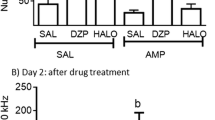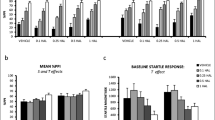Abstract
An automated tracking system which converted an animal's path between quadrants of a circular open field into a series of trips was used to analyse stereotyped locomotion in amphetamine treated rats. Amphetamine (3.5 mg/kg) increased the horizontal distance moved and the number and proportion of thigmotaxic trips around the perimeter of the apparatus (length 4 trips). To investigate the hypothesis that classic antipsychotics, but not atypical antipsychotics, would antagonise the repetitive boundary patrolling associated with amphetamine-induced hyperactivity, animals were pretreated with haloperidol (0.01, 0.025, 0.05, 0.075 mg/kg), clozapine (5, 10, 20 mg/kg) or (±)sulpiride (10, 20, 50 mg/kg) 30 min before 3.5 mg/kg amphetamine. The results showed that the classic antipsychotic haloperidol antagonised both hyperactivity and the increased proportion of length 4 trips. In marked contrast, the atypical antipsychotics clozapine and sulpiride antagonised hyperactivity but did not reduce the proportion of length 4 trips. The inability of atypical antipsychotics to reduce the repetitive boundary patrolling associated with amphetamine-induced hyperactivity is consistent with the action of these drugs on other forms of amphetamine-induced stereotyped behaviour, and indicates that locomotor routes under amphetamine are stereotyped. The measurement of trip lengths provides a sensitive tool for examining drug action on the spatial distribution of open field locomotion.
Similar content being viewed by others
References
Costall B, Domeney AM, Naylor RJ, Tyers MB (1987) Effects of the 5-HT3 receptor antagonist, GR38032F, on raised dopaminergic activity in the mesolimbic system of the rat and marmoset brain. Br J Pharmacol 92:881–894
Creese I, Iversen SD (1975) The pharmacological and anatomical substrates of the amphetamine response in the rat. Brain Res 83:419–436
Geyer MA (1990) Approaches to the characterization of drug effects on locomotor activity in rodents. In: Alder MW, Cowan A (eds) Modern methods in pharmacology vol 6. Testing and evaluation of drugs of abuse. Wiley-Liss, New York, pp 81–99
Geyer MA, Russo PV, Segal DS, Kuczenski R (1987) Effects of apomorphine and amphetamine on patterns of locomotor and investigatory behaviour in rats. Pharmacol Biochem Behav 28:393–399
Green AR, Costain DW (1981) Pharmacology biochemistry of psychiatric disorders. Wiley, New York, pp 104–128
Howell DC (1982) Statistical methods for psychology, 2nd edn. Duxbury Press, Boston
Kelly PH, Seviour PW, Iversen SD (1975) Amphetamine and apomorphine responses in the rat following 6-OHDA lesions of the nucleus accumbens septi and corpus striatum. Brain Res 94:507–522
Kenyon P (1990) TRACKER: computer assisted analysis of animal motor activity. Laboratory Microcomputer 9:50–59
Kenyon P (1991) STEREO: a program to analyse stereotyped open field locomotion. Curr Psychol Res Rev 9[4]:333–337
Kenyon P, Moore S, Hampson J (1992) Effect of sulpiride on amphetamine-induced activity and stereotyped locomotion. Curr Psychol Res Rev 11:241–253
Ljungberg T, Ungerstedt U (1978) Classification of neuroleptic drugs according to their ability to inhibit apomorphine-induced locomotion and gnawing: evidence for two different mechanisms of action. Psychopharmacology 56:239–247
Ljungberg T, Ungerstedt U (1985) A rapid and simple behavioural screening method for simultaneous assessment of limbic and striatal blocking effects of neuroleptic drugs. Pharmacol Biochem Behav 23:479–485
Lyon M, Robbins T (1975) The action of central nervous system drugs: a general theory concerning amphetamine effects. In: Essman W, Valzelli L (eds) Current developments in psychopharmacology, vol. 2. Spectrum, New York, pp 79–163
Mueller K, Hollingsworth EM, Cross DR (1989a) Another look atd-amphetamine-induced stereotyped locomotor activity in rats using a new statistic to measure locomotor stereotypy. Psychopharmacology 97:74–79
Mueller K, Kunko PM, Whiteside D, Haskett C (1989b) Time course of amphetamine-induced locomotor stereotypy in an open field. Psychopharmacology 99:501–507
Paulus MP, Geyer MA (1991) A temporal and spatial scaling hypothesis for the behavioral effects of psychostimulants. Psychopharmacology 104:6–16
Paulus MP, Geyer MA, Gold LH, Mandell AJ (1988) Assessing complexity of rat locomotor behaviour using invariant measures from ergodic theory. Soc Neurosci Abstr 14:221
Pijnenburg AJJ, Van Rossum JM (1973) Stimulation of locomotor activity following injection of dopamine into the nucleus accumbens. J Pharm Pharmacol 25:1003–1005
Rebec GV, Bashore T (1984) Critical issues in assessing the behavioural effects of amphetamine. Neurosci Biobehav Rev 8:153–159
Robertson A, MacDonald C (1984) Atypical neuroleptics clozapine and thioridazine enhance amphetamine-induced stereotypy. Pharmacol Biochem Behav 21:97–101
Robertson A, MacDonald C (1985) Opposite effects of sulpiride and metoclopromide on amphetamine-induced stereotypy. Eur J Pharmacol 36:181–188
Schiorring E (1979) Study of the stereotyped locomotor activity in amphetamine treated rats. Psychopharmacology 66:281–287
Schremmer C, Morgenstern R, Fink H, Ott T (1990) Atypical neuroleptics suppress dopaminergic behavioural supersensitivity. Psychopharmacology 100:399–403
Sharp T, Zetterstrom T, Ljungberg T, Ungerstedt U (1986) Effect of sulpiride on amphetamine-induced behaviour in relation to changes in spatial dopamine release in vivo. Eur J Pharmacol 129:411–415
Szechtman H, Eilam D, Teitelbaum P, Golani I (1988) A different look at measurement and interpretation of stereotyped behaviour. Psychobiology 16:164–173
Tamminga CA, Gerlach J (1987) New neuroleptics and experimental antipsychotics in schizophrenia. In: Meltzer HY (ed) Psychopharmacology: the third generation of progress. Raven, New York, pp 1129–1139
Tschanz JT, Rebec GV (1989) Atypical antipsychotic drugs block selective components of amphetamine-induced stereotypy. Pharmacol Biochem Behav 31:519–522
White IM, Ciancone MT, Haracz JL, Rebec GV (1992) A lever-release version of the conditioned avoidance response paradigm: effects of haloperidol, clozapine, sulpiride, and BMY-14802. Pharmacol Biochem Behav 41:29–35
Author information
Authors and Affiliations
Rights and permissions
About this article
Cite this article
Moore, S., Kenyon, P. Atypical antipsychotics, clozapine and sulpiride do not antagonise amphetamine-induced stereotyped locomotion. Psychopharmacology 114, 123–130 (1994). https://doi.org/10.1007/BF02245453
Received:
Revised:
Issue Date:
DOI: https://doi.org/10.1007/BF02245453




